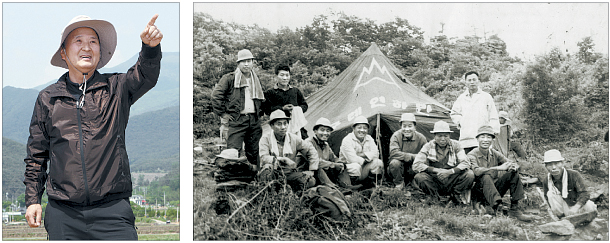How Jiri became a national park and kicked off a radical new trend

Left: Woo Du-seong, 65, president of a conservationist association for Mount Jiri. Right: Members of Yeonhaban, a hiking group of residents of Gurye, South Jeolla, gather around. After multiple appeals to the National Assembly, Mount Jiri was designated the first national park of Korea in 1967 due to their efforts. [OH JONG-CHAN, WOO DU-SEONG]
Born around Mount Jiri, 65-year-old Woo Du-seong, the president of a conservationist association for Mount Jiri, spoke on Monday as he recollected the events that took place in his youth. It is now 50 years since Mount Jiri was designated the first national park in Korea on December 1967.
“We collected 100,000 won from 10,000 households paying 10 won each,” said Woo. “In 1963, the money could have bought a house in this neighborhood.”
National parks were nonexistent at the time and the first to embark on conservation originated from the bottom-up by Gurye, South Jeolla, residents, including Woo’s father, Woo Jong-su (now deceased).
“According to residents in the area in the early 1960s, in just Gurye alone there were 250 trucks carrying loads on the streets daily. Portable sawmills with circular saws connected to the top of military-grade truck engines were everywhere in valleys.”
Feeling the hurt more than anyone else were the residents of Gurye who had spent their entire lives under the majesty of Mount Jiri. Among them, members of Yeonhaban, a local recreational hiking club, were especially indignant at the sight of these brazen sawmills.
Woo’s father, a teacher at Gurye Middle School, was Yeonhaban’s secretary. In Woo and Yeonhaban’s perspective, the complete despoiling of Mount Jiri was just a matter of time. Yeonhaban set their goal of designating Mount Jiri as the country’s first national park and founded the national park designation committee. As Korea lacked an official or legal definition of what such a national park may be, the Yeonhaban’s first task was for legislative clarity.
Campaign funds were a necessity and Gurye residents cooperated in a concerted effort to collect the required amount. Of the 12,000 households residing in the area, 10,000 households participated. Each of these households contributed an initial 10 won in 1963 for 10,000 won and three years later, they doubled their donation to 20 won a piece for a total of 200,000 won.
The committee traveled to Seoul countless times to propose conservation to the central government. In three years, the National Assembly and government showed an interest and the Natural Park Act was put into legislation in March 1966.
After the legislation of the act, the government dispatched a fact-finding group to the area. Woo senior was also involved on the ground.
Including Mount Jiri’s designation as a national park in 1967, there are now 22 such parks in the country.
“The experience and techniques from the restoration efforts for the Asiatic black bear that started at Mount Jiri can also be used for the restoration of mountain goats or foxes at other national parks,” said Shin Yong-seok, a manager for the National Park Service at Mount Jiri.
This year is particularly significant as it marks the 50th and 30th year anniversaries of the first Korean national park and the establishment of the Korea National Park Service. Since April, national parks across the country are hosting “3050” events in commemorating these two milestones. There was a celebration held at the Sejong Center for the Performing Arts in central Seoul on Monday.
BY KANG CHAN-SU [hwang.hosub@joongang.co.kr]










with the Korea JoongAng Daily
To write comments, please log in to one of the accounts.
Standards Board Policy (0/250자)